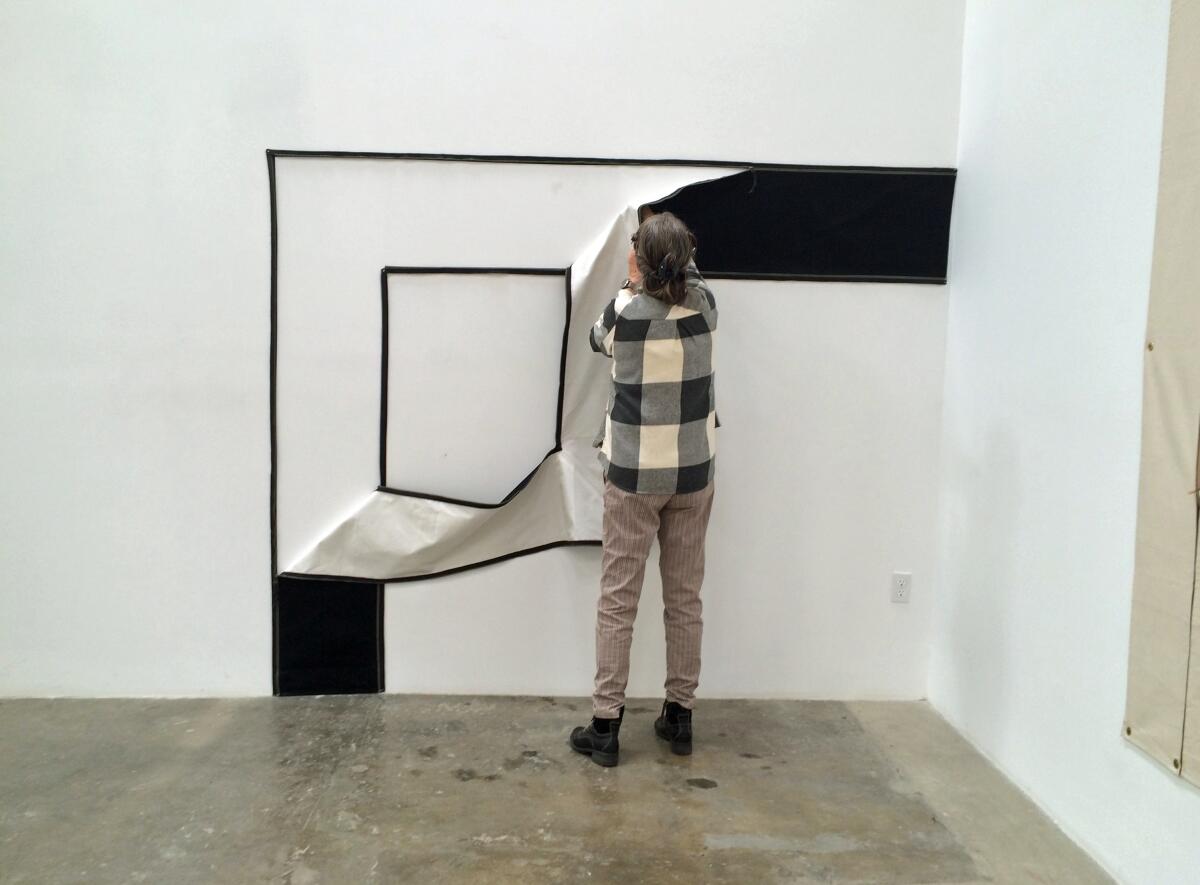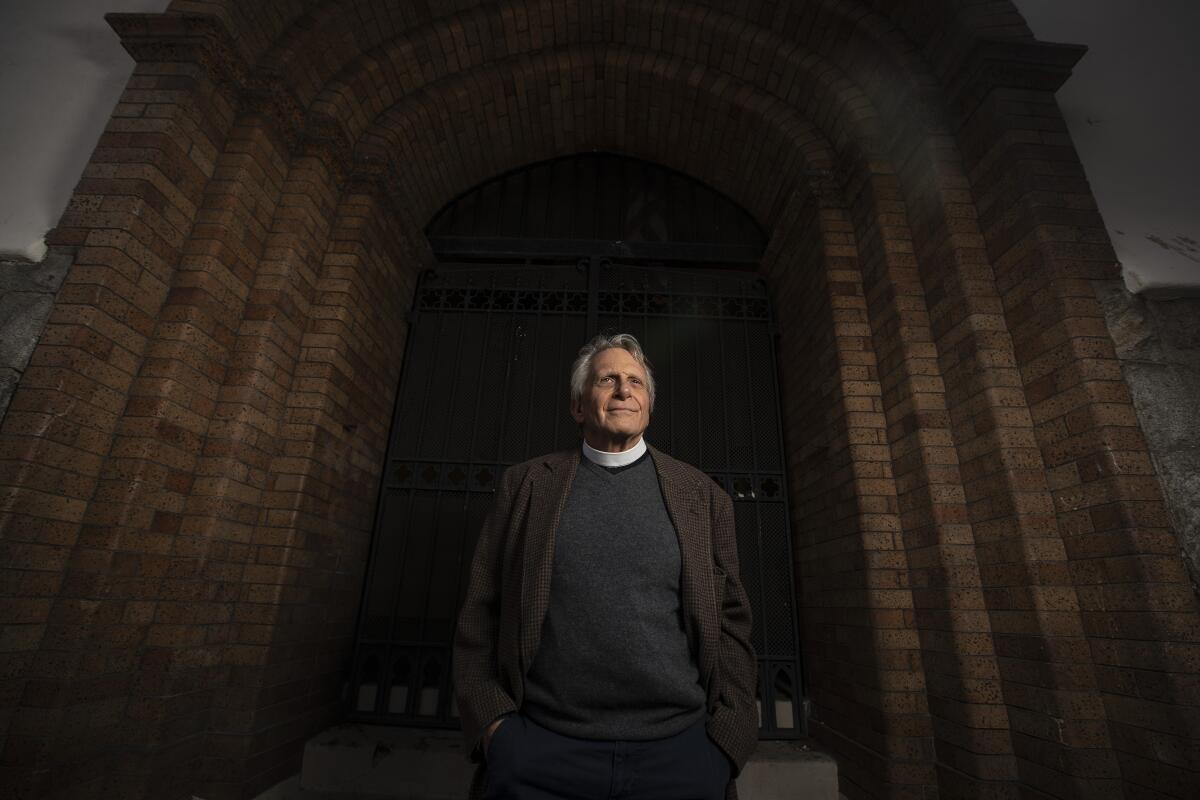Essential Arts: With a zipper, Karen Carson adds sensuousness to chilly minimalism
- Share via
Greetings from our ongoing pandemic, where we’re all a little bit of Mads Mikkelsen in the Danish dramedy “Another Round.” I’m Carolina A. Miranda, culture and urban design columnist for the Los Angeles Times, rounding up the week’s essential art news — and satirical architecture speak:
Minimalism, but make it tingle
For her graduate show at UCLA in 1971, Karen Carson presented a series of works that consisted of simple geometric pieces of fabric — sometimes produced in two or three tones — that were bound together by zippers. These were pinned to a wall and could be manipulated by viewers who were invited to open and close the zippers, changing the shape of the piece in the process.
The works, known as the “zipper” series, take the tropes of minimalism — its remoteness, its chilly control (think of Donald Judd’s stainless steel) — and imbues it with sensuousness. To tug at a zipper is to feel the tingling anticipation of fabric that is about to be shed. Carson cedes that control to the viewer, who with a few pulls, can determine the final form of the work. It is a minimalism of total release.
These works take a hard edge and make it soft. They take an area of art dominated by men and imbue it with feminine craft. (There is no outsourcing to a fabricator here; Carson sews these herself.) And in an age of art with towering carbon footprints — the room-sized installation, the architectural environment — I deeply admire the fact that the zipper pieces can make a bold statement, then be folded up and easily transported to another site.
Of these works, independent critic Dave Hickey told Times contributor Hunter Drohojowska-Philp in 1996: “They were investigating the parochial unctuousness of minimalism with a cosmopolitan irony. They were smart, funny, good-looking and secretly serious.”
Make the most of L.A.
Get our guide to events and happenings in the SoCal arts scene. In your inbox once a week.
You may occasionally receive promotional content from the Los Angeles Times.
A small selection of Carson’s zipper pieces is on view at Gavlak gallery in the Arts District in the solo exhibition “Karen Carson: Middle Ground.” And, I for one, couldn’t be happier to become reacquainted with them. The last time I saw these works was in an exhibition the artist had at Rosamund Felsen Gallery in 2016, where I happened to catch her installing the pieces as I cruised through. Ever since I’ve regretted not writing about that show since the work is so smart and so wry and so wildly under-seen.
It feels like a crime that New York’s Museum of Modern Art doesn’t have one of these in their minimalism galleries. Also, ahem, the Museum of Contemporary Art Los Angeles — one of Carson’s hometown institutions.

The show at Gavlak also includes a series of recent works by the artist: bas relief paintings that layer pieces of wood frames to create geometric patterns that are then highlighted with color — colors that evoke Southwestern palettes. (Imagine a Georgia O’Keeffe flower painting that has been exploded, then reassembled in three dimensions out of angular bits of wood.)
As with her zipper paintings, there is a sensuousness to these works. Carson’s brush strokes are visible throughout. In some patches, she saturates the wood; in others, she lets flashes of color shine through. These are objects that are resolutely handmade, not machine-crafted. The patterns seem to evoke interior states of both mind and body — in some cases, women’s bodies and the life forces they contain.
And at a time of so much death, a little female life force is a welcome thing. Do not miss.
“Karen Carson: Middle Ground” is on view at Gavlak through March 6. The gallery is currently open by appointment in keeping with social distancing protocols.
Art and artists
Minimalism is the perfect segue to light and space — or is it space minus light? Times art critic Christopher Knight paid a visit to Robert Irwin’s solo show at Kayne Griffin. Irwin, who has been employing fluorescent light in his installations for decades, continues to use them in form if not in function, employing the tubes but without turning them on. These “unlights” are “remarkable,” writes Knight. “Think of stripe paintings by artists like Gene Davis or Bridget Riley, except three-dimensional and made from hardware instead of acrylic and canvas.”
Also on Knight’s docket is the Gerhard Richter show at Gagosian in Beverly Hills. A survey of the artist’s work that originated at the Metropolitan Museum of Art in New York was scheduled to travel to MOCA, but had been canceled due to the pandemic. Thankfully, we can still get a taste of Richter at the gallery, which is displaying the German painter’s “Cage” series, which had not previously been seen in the U.S. — and was inspired by the L.A.-born composer.
Reporter Deborah Vankin has a remarkable story about a painting that was fabricated in prison, was lost, then found, and is now in the Hammer Museum’s “Made in L.A” biennial (which will hopefully be given a chance to open). The piece, titled “Mondaine’s Market,” was created by Compton artist Fulton Leroy Washington, known as Mr. Wash, who created another version of the work when he was initially unable to locate the original. Both pieces now hang in the biennial — one at the Hammer and the other at the Huntington Library. But the exercise says Wash, “It made me question myself. Are the energies of paintings equal in terms of detail, depth, the amount of time?”
Performing arts
Black Lives Matter Global Network debuted an artist series this month to celebrate the legacy of Martin Luther King Jr., featuring the work of six artists that were showcased on the organization’s website as well as on Instagram. Shaina Simmons’ performance art video “Twerk on Washington” generated heated overreaction for showing the artist twerking at iconic Washington, D.C., sites while wearing a pair of American flag shorts. The Times’ Makeda Easter spoke to the artist about the genesis of her work. “Twerk on Washington,” she writes, “explores what it means to reclaim traditional dances on American soil.”
Times theater critic Charles McNulty writes about how we define the art of theater when we are all stuck behind a screen. Even online, “place still matters,” he writes. “After spending so many hours of home confinement watching plays and performance pieces on my laptop, I discovered that I’m more wholly engaged when a virtual offering is anchored in a location, be it geographical or cultural, that has a resonance for me.”
Design time
The Church of the Epiphany, a Lincoln Heights church that helped harbor the Chicano civil rights movement, has been officially added to the National Register of Historic Places. The Times’ Jessica Gelt reports that the designation is significant: According to the L.A. Conservancy’s Linda Dishman, “only 10% of the city’s 1,203 historic cultural monuments are associate with women or with BIPOC or LGBTQ communities.” (Nationally, the stat is less than 8%.) Architects Escher GuneWardena have been helping restore the church, which was built in 1887.

In a spot of good news: My colleague Doug Smith has a report on a modular 232-bed development on Vignes Street that has taken a brisk five months to erect. The shipping container architecture was created by VESTA Modular and repurposed by the Carson-based CRATE, a container conversion company.
Enjoying this newsletter? Consider subscribing to the Los Angeles Times
Your support helps us deliver the news that matters most. Become a subscriber.
Preservationists have been urging L.A.’s cultural heritage commission to turn the old Taix restaurant in Echo Park into a cultural monument. But in the midst of a housing crunch, Curbed’s Alissa Walker says maybe we don’t need to preserve every unremarkable building in L.A. — especially when the new development will have 24 deed-restricted units for very low-income residents.
The San Francisco Chronicle’s Heather Knight asks: How San Francisco becomes one of California’s most conservative cities when it comes to housing.
A short follow-up to my report about Paul R. Williams: Architectural historian Brian Goldstein did a great Twitter thread about a patent that was registered by the architect. It’s for an adjustable table he designed with Richard Neutra, which in the past has been attributed solely to Neutra.
Need a break from your four walls? Times photographer Myung Chun and contributor Sharon Boorstin have put together a 1970s architectural driving tour of Los Angeles.
Essential happenings
Matt Cooper has all the listings, including 21 online culture picks that include play readings, a spoken word performance by Syrian American artist Omar Offendum and a star-studded benefit to support school theater featuring Tina Fey, Samuel L. Jackson, Audra McDonald and many more.
Cooper also comes through with six L.A. and O.C. happenings going down IRL, including an audiovisual installation at the Music Center and a pop-up drive-in event staged by Dance Camera West.
Passages
Cicely Tyson, who was a trailblazer on stage and screen — and won a Tony as recently as 2013 for her starring role in “The Trip to Bountiful” has died at 96.
Cloris Leachman, who found success in the theater in “As You Like It” opposite Katharine Hepburn and after a rich TV and film careerbecame at 82 the oldest contestant on “Dancing With the Stars,” has died at 94.
Pauline Anna Strom, a San Francisco composer whose experimental homemade recordings drew fans from across genres, is dead at 74. The composer, who was blind, was never limited by her lack of sight: “My hearing and inner visualization have, I feel, developed to a higher level than perhaps they would have otherwise.”
Bob Avian, a Tony Award-winning choreographer who helped staged beloved Broadway shows such as “Dreamgirls” and “A Chorus Line” has died at 83.
Corky Lee, a photographer who used his lens to make visible the Asian presence in the United States, is dead at 73 due to COVID-19.
In other news
— Oh hey, L.A., if we’re going to reopen nail salons, maybe we can reopen museums? These are, after all, places where no one actually touches anything and unlike a manicure, it’s feasible to remain more than six feet apart at all times.
— Tenor Russell Thomas has been named L.A. Opera’s artist in residence, succeeding composer and conductor Matthew Aucoin, who held the position from 2016 to 2020.
— This poignant essay by Daniel Loedel, about the disappearance of his sister by the Argentinean military, is a must.
— Leon Black is stepping down as chair of Apollo Global Management after it was revealed that he had paid $158 million to Jeffrey Epstein. But he remains chairman of the board at MoMA.
— The Getty Foundation has announced a round of $5 million research grants for the next Pacific Standard Time series, “Art x Science x L.A.”
— The Cheech Marin Center for Chicano Art is slated to open this fall in Riverside.
— This essay by Steve Locke is the best I’ve read on why Philip Guston‘s art is so important.
— “An idiosyncratic bagatelle ... more Spalding Gray than Bob Ross ... finds [John Lurie] making pictures and telling stories on the unnamed, tropical “tiny island” he calls home.” Adding HBO’s “Painting with John” to my streaming list.
— I dig Lorna Simpson’s collages of Rihanna for Essence magazine.
And last but not least ...
“What if you could get infinitely close to being indoors, while remaining, by some convoluted set of standards, outdoors?” McSweeney’s takes on the architecture of outdoor dining structures.
The biggest entertainment stories
Get our big stories about Hollywood, film, television, music, arts, culture and more right in your inbox as soon as they publish.
You may occasionally receive promotional content from the Los Angeles Times.




